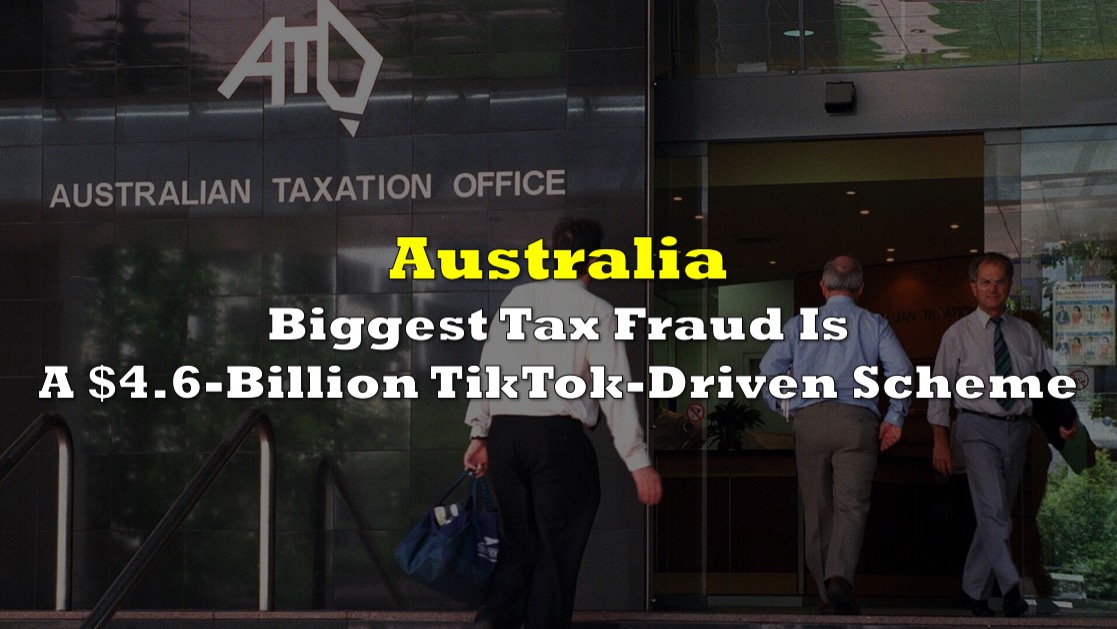A staggering revelation has emerged from the Tax Office of Australia, acknowledging its disbursement of over $1.6 billion in counterfeit Goods and Services Tax (GST) claims, forming part of an intricate $4.6 billion fraudulent scheme masterminded through a simplistic ploy propagated on the social media platform TikTok. This sum is double the previously reported figures and stands as the largest tax fraud in the annals of Australian history.
The curtains were drawn back on this audacious fraud by Westpac, alongside other financial institutions, which diligently transmitted a sequence of cautionary alerts to the Tax Office starting in 2020. However, confronted with what seemed to be a lack of proactive measures from the Tax Office, certain bank personnel informally conveyed their apprehensions to the Reserve Bank. This consequential exchange prompted a chain reaction that alerted both Treasury and the Tax Office in February 2021.
Dubbed Operation Protego, the Tax Office initiated a pursuit of the fraud on April 11 of the same year. Consequently, a series of law enforcement raids spearheaded by the federal police have led to the apprehension of more than 100 individuals. Additionally, punitive actions have been taken against a staggering 56,000 individuals. Notably, the ATO (Australian Taxation Office) has been operating primarily incognito.
Deputy Commissioner Will Day, at the helm of Operation Protego, disclosed, “We have stopped in the order of $2.7 billion in fraudulent refunds and raised liabilities in the order of $1.9 billion, as at 30 June 2023.” Among these liabilities, penalties and interest contribute a substantial $300 million.
In the epicenter of this financial misconduct, accountants situated in western Sydney—where the fraudulent scheme went viral in the midst of 2021—have reported an ongoing influx of novel instances as clients file their tax returns, implying the perpetuation of this fraudulent activity.
Beginning in late 2020, financial institutions noticed a surge in suspicious transactions, involving beneficiaries of social welfare who inexplicably received substantial business payments, some surpassing $100,000, purportedly from the Tax Office. Swift to respond, the banks placed holds on these accounts and promptly notified the Tax Office about the perplexing transactions. Frustration mounted, however, as the Tax Office remained unresponsive to these reported discrepancies.
Crazy from @NeilChenoweth — The Australian tax office is grappling with a $4.5 billion fraud scheme, the largest in history, whereby TikTok influencers explained to people how they could falsely claim GST refunds. https://t.co/a7um21BqTh pic.twitter.com/Y9LkEaiPcv
— Mark Di Stefano (@MarkDiStef) August 13, 2023
TikTok-driven fraud
The Tax Office justified its lack of communication with the banks by citing taxpayer secrecy laws. Notably, internal divisions within the Tax Office contributed to the discord regarding the department responsible for addressing the matter.
2021 witnessed an explosive proliferation of the fraud, fueled by social media influencers on TikTok describing the methodology to their followers, resulting in an avalanche of applications for government “loans.”
The ruse entailed individuals acquiring an Australian Business Number (ABN) and subsequently employing their MyGov accounts to solicit GST refunds against fictitious expenses ostensibly incurred during the establishment of their purported businesses.
Initial Tax Office reports suggested an average claim amount of $20,000; however, accountants operating in western Sydney contended that among their client base, the average fraudulent claim far exceeded $80,000.
As the fraud gained virality, the Tax Office’s preventive mechanisms faltered under the overwhelming influx of counterfeit refund claims pouring in daily from thousands of individuals.
By early the following year, the banks, collaborating with the FinTel alliance established by Austrac to assess the scale of the fraud, found themselves at a loss concerning the frozen accounts, faced with what appeared to be inertia on the part of the ATO.
Amidst this climate, certain bank executives reached out informally to the Reserve Bank, eventually leading to a meeting with the Tax Office in mid-February of the same year.
In response to media inquiries, the banks and the Reserve Bank of Australia redirected questions to the Tax Office, with Deputy Commissioner Day vehemently denying any allegations of inactivity by the ATO.
“When our combined intelligence first discovered the rapidly escalating fraud attempts in early 2022, we swooped in quickly,” asserted Day. “By late February 2022, we had dialed up our efforts to put a stop to these fraudulent attempts to a ’10 out of 10’. We pushed our efforts to an ‘11’ when we commenced Operation Protego.”
Operation Protego
May 2022 marked the official launch of Operation Protego by the Tax Office. This initiative was set into motion after a convergence of sophisticated risk models deployed by the ATO, coupled with intelligence sourced from financial institutions, particularly through the Austrac-led Fintel Alliance and the Reserve Bank of Australia, unveiled a marked surge in dubious refunds.
Initial figures declared by the Tax Office indicated that $850 million had been disbursed as part of the fraudulent claims, with Protego thwarting over $1 billion in additional claims. Notably, a sum of $66 million had been recouped, predominantly from accounts immobilized by the banks.
The Tax Office’s annual report for the same year underscored the challenging nature of recovering refunds already issued, given the fraudulent underpinning of the activities and the compromised financial standing of numerous perpetrators.
A report in February of the same year highlighted the prevention of $2.5 billion in claims, but omitted any reference to the actual payout amount.
Included in the latest aggregate are findings from a limited inquiry into the fraud conducted prior to the aforementioned year.
Day elucidated, “Our initial focus was on stopping fraudulent refunds before they were issued. When we identified taxpayers who had made multiple attempts to participate in this fraud, even after we had declared Operation Protego, we looked closely at their previous lodgment history and, in some instances, discovered prior offending. We took action against this fraud too.”
Furthermore, Day reported a significant deceleration in fraudulent attempts in recent months, signifying a positive trend in the ongoing efforts to combat fraud.
Information for this story was found via Financial Review and the sources mentioned. The author has no securities or affiliations related to the organizations discussed. Not a recommendation to buy or sell. Always do additional research and consult a professional before purchasing a security. The author holds no licenses.









